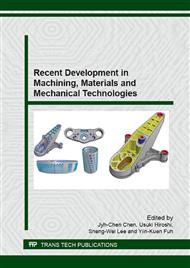[1]
J. Lee, B. Feng, A thermodynamic study of the removal of HCl and H2S from syngas, Front. Chem. Sci. Eng. 6(1), (2012) 67-83.
DOI: 10.1007/s11705-011-1162-4
Google Scholar
[2]
X. Meng, W. de Jong, R. Pal, A.H.M. Verkooijen, In bed and downstream hot gas desulphurization during solid fuel gasification: A review, Fuel Processing Technology 91, (2010) 964-981.
DOI: 10.1016/j.fuproc.2010.02.005
Google Scholar
[3]
W.F. Elseviers, H. Verelst, Transition metal oxides for hot gas desulphurization, Fuel 78, (1999) 601-612.
DOI: 10.1016/s0016-2361(98)00185-9
Google Scholar
[4]
S. Cheah, D.L. Carpenter, K.A. Magrini-Bair, Review of Mid- to High-Temperature Sulfur Sorbents for Desulfurization of Biomass- and Coal-derived Syngas, Energy and Fuels 23, (2009) 5291–5307.
DOI: 10.1021/ef900714q
Google Scholar
[5]
M. Flytzani-Stephanopoulos, M. Sakbodin, Z. Wang, Regenerative Adsorption and Removal of H2S from Hot Fuel Gas Streams by Rare Earth Oxides, Science, 312, (2006) 1508-1510.
DOI: 10.1126/science.1125684
Google Scholar
[6]
D.A.R. Kay, W.G. Wilson, V. Jalan, High temperature thermodynamics and applications of rare compounds containing oxygen and sulphur in fuel gas desulphurization and SOx and NOx removal, Journal of Alloys and Compounds, 192, (1993) 11-16.
DOI: 10.1016/0925-8388(93)90295-x
Google Scholar
[7]
I. Valsamakis, R. Si , M. Flytzani-Stephanopoulos, Stability of lanthanum oxide-based H2S sorbents in realistic fuel processor/fuel cell operation, Journal of Power Sources, 195, (2010) 2815-2822.
DOI: 10.1016/j.jpowsour.2009.11.047
Google Scholar
[8]
Y. Zeng, S. Kaytakoglu, D.P. Harrison, Reduced cerium oxide as an efficient and durable high temperature desulfurization sorbent, Chem. Eng. Sci., 55, (2000) 4893-4900.
DOI: 10.1016/s0009-2509(00)00117-2
Google Scholar
[9]
P.J. Woolcock, R.C. Brown, A review of cleaning technologies for biomass-derived syngas, Biomass and Bioenergy, 52, (2013) 54-84.
DOI: 10.1016/j.biombioe.2013.02.036
Google Scholar
[10]
T.K. Tseng, L. Wang, H. Chu, High temperature cleaning for chlorine-containing coal gas by supported manganese oxide sorbent, Aerosol and Air Quality Research, 12, (2012) 961-971.
DOI: 10.4209/aaqr.2012.02.0036
Google Scholar
[11]
J. Kapfenberg, J. Sohnemann, D. Schleitzer, A. Loewen, Acid gas removal by customized sorbents for integrated gasification fuel cell systems, 5-th Internat. Symposium on Gas cleaning at high temperatures, Morgantown, Wva, USA, September 17-20 , (2002).
Google Scholar
[12]
R.A. Newby, T.E. Lippert, R.B. Slimane, O.M. Akpolat, K. Pandya, F.S. Lau, J. Abbasian, B.E. Williams D. Leppin, Novel gas cleaning/conditioning for integrated gasification combined cycle, Base program final report, prepared for DOE by Siemens Westinghouse Power corporation and Gas technology institute (DOE Aw. No.: DE-AC26-99FT40674), USA, August (2001).
DOI: 10.2172/806697
Google Scholar
[13]
R.P. Gupta, W.S. O´Brien, Desulfurization of hot flue syngas containing hydrogen chloride vapours using zinc titanate sorbents, Ind. Eng. Chem. Res., 39, (2000) 610-619.
DOI: 10.1021/ie990533k
Google Scholar
[14]
R. Akila, K.T. Jacob, A.K. Shukla, Gibbs energies of formation of rare earth oxy-sulfides, Metallurgical Transactions B, 18B, (1987) 163-168.
DOI: 10.1007/bf02658440
Google Scholar
[15]
Ju.L. Suponitzky, V.L. Laptev, Thermodynamics of the formation of oxy-sulfides of rare-earth elements, Russian Chemical Bulletin, 46, No. 2, (1997) 279-283.
DOI: 10.1007/bf02494362
Google Scholar
[16]
V.R. Kalakota, Sulfur removal using regenerable sorbents of rare earth/Transition metal oxides, Ph.D. Thesis, Dep. of Chem. Eng., Louisiana State University, USA, (2008).
DOI: 10.31390/gradschool_theses.3363
Google Scholar
[17]
A. Trovarelli, Catalytic Properties of Ceria and Ce0, -Containing Materials, Catalysis Reviews: Science and Engineering, 38(4), (2006) 439-520.
DOI: 10.1080/01614949608006464
Google Scholar
[18]
I. Barin, O. Knacke, Thermochemical data of pure substances. 3rd ed., Weinheim: VCH; (1995).
Google Scholar
[19]
O.V. Dorofeeva, L.V. Gurvich, Ideal gas thermodynamic properties of sulfur heterocyclic compounds, J. Phys. Chem. Ref. Data (1995) 1351-1376.
DOI: 10.1063/1.555962
Google Scholar
[20]
K. Svoboda, G. Slowinski, J. Rogut, D. Baxter, Thermodynamic possibilities and constraints for pure hydrogen production by iron based chemical looping process at lower temperatures, Energy Conversion and Manag. 48, (2007) 3063–3073.
DOI: 10.1016/j.enconman.2007.05.019
Google Scholar


